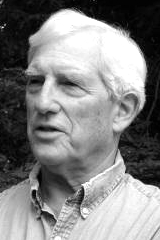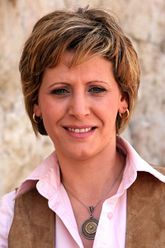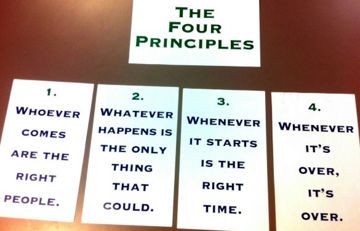Open-space
Contents
A short primer about “Open Space” meetings

The author is coordinator of the UNESCO-sponsored Israeli-Palestinian Media Forum. This brief summary of the concept of “open space” meetings was written by her in 2007.
Open Space Technology (OST) is a transformative facilitation practice that was created in the mid-1980s by organizational consultant Harrison Owen. OST events have no keynote speakers, no pre-announced schedules of workshops, no panel discussions, no organizational booths. Instead participants create their agenda together, host small group discussions and produce a set of proceedings, all using principles of self-organization and the power of passion, invitation and personal responsibility.
See: A concise description of Open Space
Through an intentional combination of order and chaos, OST resembles the creative act of a
mind moving from confusion and frustration to assimilation and discovery, but OST achieves
this transition not in one mind, but simultaneously in several. Intense, focused discussion leads
to mutual recognition of areas of agreement and disagreement, and thus lays the ground for
knowledgeable participation in the action program that concludes with the publication of a full
report on the group’s findings.
The process creates a unique spirit of community and introduces new possibilities for organizing
work in communities and organizations through invitation. This tool can be utilized by groups of
5 to over 2000 and the dynamics and results are always the same: input from stakeholders at all
levels, new ways of thinking and working, large amounts of work done rapidly, bringing
perceived competitors together on issues and projects, organizational flexibility,
interdepartmental or intercommunity teamwork, a sense of accomplishment and a feeling of
passion and energy for the challenges ahead.
Guidelines for an Open Space Meeting
The rules are simple, although setting up the parameters for a meeting or conference in Open
Space is based on the theories of complexity, self-organization and open systems. Do you know
how sometimes when you go to a conference or a meeting, the best ideas, networking,
brainstorming and deal making happen during the coffee breaks? Open Space Technology is
designed to simulate that natural way people find each other and share ideas in all different
cultures and countries. It is also based on the understanding that there is a great amount of
wisdom and experience in any gathered group of people - that we are all 'experts' and can all
contribute - a true democratic process.
It all starts with a circle of chairs, without a pre-designed agenda. The group sets their own
agenda by identifying issues and topics that have heart and meaning for them; topics for which
they have passion and interest and for which they are willing to host a discussion group. Small
group discussions happen throughout the day, with participants moving from group to group
whenever they feel that they can no longer learn or contribute to a discussion, or when they feel
drawn to another topic.
There are four simple guidelines
- 1. Whoever comes is the right person. Rather than wait for the 'expert' on a given issue, realize that whoever is moved to come to your discussion group has been moved by his or her passion for the issue, not just his or her organizational role. The best and brightest are convening to discuss something they really care about - across departmental or hiearchial lines. And what if nobody comes to your session? It may be that either you are a visionary ahead of your time, or that there are so many great topics to choose . . . either way you have the choice to either join in another discussion or spend the time writing your thoughts down to enter into the meeting proceedings.
- 2. Whatever happens is the only thing that could have. Don't try to control the discussion - even if it goes off on a tangent -- that may be exactly the direction for the breakthrough of new ideas. Follow the energy of the group. By the way, the only time that Open Space does not work is when somebody in charge feels they must control the outcome of the discussion or the event.
- 3. Whenever it starts is the right time. ¨Don't wait for some specific person to arrive; begin with whoever is drawn to the discussion. It's a reminder that creativity does not happen according to a schedule but starts when it starts.
- 4. When it’s over, it’s over. ¨You may settle the problems of the world in 20 minutes; on the other hand, you may wish to continue your discussion for longer than the allotted time. Creativity and intuitive thinking do not happen according to a schedule - take it where it wants to go. If you're done early you can join another group; if you take longer, just move your discussion elsewhere to make way for the next group scheduled.
There is only one law: The Law of Two Feet
(also called the Law of Motion and Responsibility)
If you feel you are neither learning from nor contributing to a discussion, you are required to get
up and move to another discussion, without waiting for the group to complete its conversation.
Your fresh insights and creative thoughts are needed elsewhere. Whereas in some cultures this
may be seen as rude and disrespectful, in Open Space it would actually be disrespectful to the
process and to the greater group to sit and stay in a discussion for which you felt you were not
being useful. The result is a room alive with movement and animated discussion as people travel
from group to group to use their best energy and thinking where it is most needed.
This Law creates two animals: Bumblebees and Butterflies.
Bumblebees are those who sign up for many things at the same time; it's possible to be in multiple places at once. Butterflies: they look very delicate and they're deceptive in their impact. In open space everyone is valued, and so there are not guilt feelings.
The final guideline is to: Be Prepared to Be Surprised.
If you carry your preconceived agenda into a conversation, you may never receive the greater
results and more intuitive thinking that can come from a group of diverse and passionate people
taking a conversation where it can go.
Who is in control here?
How can OST be productive without a pre-designed agenda or outcome and little or no
intervention by a facilitator? Won't that create chaos? Won't chaos lead to catastrophe? Where is
the structure? Actually there is very specific structure to the OST process -- just not the structure
people usually create in meetings. The result is a new way of working, thinking and
communicating, and the results are innovative, concrete, positive, and substantial.
ADDITIONAL RESOURCES ABOUT OPEN SPACE
- http://en.wikipedia.org/wiki/Open-space_technology
- http://www.openspaceworld.org/
- http://www.openspaceworld.org/tmnfiles/choosingopenspace%28Bolton%29.html
- http://openspaceworld.ning.com/
- http://www.michaelherman.com/cgi/wiki.cgi?OpenSpaceTechnology
- Open Space Technology: A Users' Guide, by Harrison Owen:
- http://www.amazon.com/Open-Space-Technology-Users-Guide/dp/1576754766
VIDEO: https://vimeo.com/13918372
- Peggy Holman explains:


